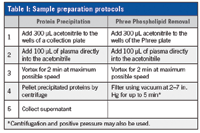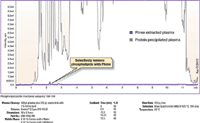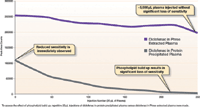Rapid Improvements for LC–MS-MS Analysis Using the New Phree? Phospholipid Removal Plates
When performing LC–MS-MS analysis, phospholipids are perhaps one of the most troublesome components of bioanalytical samples. The presence of phospholipids not only reduces the column lifetime and sensitivity but can also cause a phenomenon known as ion suppression.
When performing LC–MS-MS analysis, phospholipids are perhaps one of the most troublesome components of bioanalytical samples. The presence of phospholipids not only reduces the column lifetime and sensitivity but can also cause a phenomenon known as ion suppression.
This work compares the presence of phospholipids in plasma samples after two different sample preparation techniques, protein precipitation and simultaneous protein precipitation and phospholipid removal using a new product, Phree.

Table I: Sample preparation protocols
Experimental Conditions
Plasma samples from the same lot were prepared (Table I) and were injected on a Kinetex® 2.6 µm C18 core–shell column coupled with an API 3000 MS (AB SCIEX) (Figure 1). A total phospholipid profile was monitored using m/z 184–184.

Figure 1: Total phospholipid profile.
Results and Discussion
When monitoring the total phospholipid profile, the protein precipitated plasma showed a large amount of phospholipids. In comparison, the plasma sample that was prepared using Phree showed virtually no phospholipids (Figure 1).
We also studied analyte response by comparing diclofenac spiked plasma samples. After sample preparation, 20 µL samples were injected on a Kinetex® 2.6 µm C18 core–shell column. The diclofenac signal in the protein precipitated samples was immediately lower than the signal in the Phree extracted samples. The signal in the protein precipitated sample rapidly decreases. The Phree extracted sample shows a steadier signal and is able to withstand > 250 injections (Figure 2). The higher signal strength of the Phree extracted sample is due to the reduction of phospholipid induced ion suppression. The significant reduction in phospholipid build up on the column and MS source also resulted in an increase in column lifetime and a decrease in the amount of MS maintenance required.

Figure 2: Column sensitivity after 250 injections.
Conclusion
By preparing samples with Phree, analysts can remove proteins and phospholipids in four short steps resulting in immediate improvements to their chromatography work.
For more information about Phree, visit www.phenomenex.com/Phree
Phenomenex, Inc.
411 Madrid Avenue, Torrance, CA 90501
tel. (310) 212-0555, (310) 328-7768
Website: www.phenomenex.com

SEC-MALS of Antibody Therapeutics—A Robust Method for In-Depth Sample Characterization
June 1st 2022Monoclonal antibodies (mAbs) are effective therapeutics for cancers, auto-immune diseases, viral infections, and other diseases. Recent developments in antibody therapeutics aim to add more specific binding regions (bi- and multi-specificity) to increase their effectiveness and/or to downsize the molecule to the specific binding regions (for example, scFv or Fab fragment) to achieve better penetration of the tissue. As the molecule gets more complex, the possible high and low molecular weight (H/LMW) impurities become more complex, too. In order to accurately analyze the various species, more advanced detection than ultraviolet (UV) is required to characterize a mAb sample.















